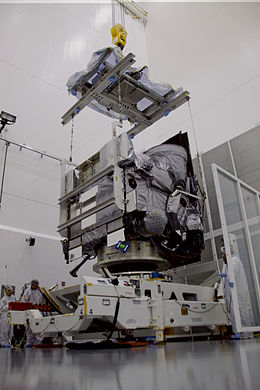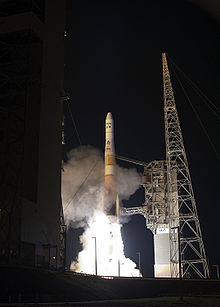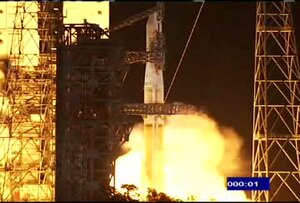GOES 15
 GOES 15 during pre-launch processing | |
| Mission type | Weather satellite |
|---|---|
| Operator | NOAA / NASA |
| COSPAR ID | 2010-008A |
| SATCAT no. | 36411 |
| Mission duration | 10 years (planned) Elapsed: 9 years, 10 days |
| Spacecraft properties | |
| Spacecraft type | GOES-N series |
| Bus | BSS-601 |
| Manufacturer | Boeing ITT Corporation |
| Power | 2.3 kilowatts from solar array |
| Start of mission | |
| Launch date | 4 March 2010, 23:57 (2010-03-04UTC23:57Z) UTC |
| Rocket | Delta IV-M+(4,2) |
| Launch site | Cape Canaveral SLC-37B |
| Contractor | United Launch Alliance |
| Orbital parameters | |
| Reference system | Geocentric |
| Regime | Geostationary |
| Longitude | 128° West |
| Slot | GOES-WEST |
| Semi-major axis | 42,166 kilometres (26,201 mi) |
| Perigee | 35,791.0 kilometres (22,239.5 mi) |
| Apogee | 35,800.4 kilometres (22,245.3 mi) |
| Inclination | 0.2º |
| Period | 1,436.2 minutes |

GOES 15 launches from Cape Canaveral Air Force Station SLC-37B, March 4, 2010.
GOES 15, previously known as GOES-P, is an American weather satellite, which forms part of the Geostationary Operational Environmental Satellite (GOES) system operated by the U.S. National Oceanic and Atmospheric Administration. The spacecraft was constructed by Boeing, and is the last of three GOES satellites to be based on the BSS-601 bus. It was launched in 2010, while the other BSS-601 GOES satellites -- GOES 13 and GOES 14 -- were launched in May 2006 and June 2009 respectively.[1] It was the sixteenth GOES satellite to be launched.
Contents
1 Launch
2 Design
3 Retirement
4 Media
5 References
6 External links
Launch
GOES 15 was launched atop a Delta IV-M+(4,2) rocket flying from Space Launch Complex 37B at the Cape Canaveral Air Force Station.[2][3] The launch occurred at 23:57 GMT on 4 March 2010, forty minutes into a sixty-minute launch window. Upon reaching geostationary orbit on 16 March, it was redesignated GOES 15.[3][4] On December 6, 2011, it was activated as the GOES West satellite, replacing GOES 11.[5]
Design
At launch, the mass of the satellite was 3,238 kilograms (7,139 lb). It has a design life of ten years. Power is supplied by a single gallium arsenide solar panel, which provides up to 2.3 kilowatts of power. A 24 cell nickel hydrogen battery is used to provide power when the satellite is not in sunlight.[6] Instruments aboard GOES 15 include a five channel multispectral imager to capture visible light and infrared images of the continental United States, a sounder to take readings of atmospheric temperature and moisture, a solar x-ray imager to detect solar flares, and instruments to monitor the magnetosphere, cosmic background radiation and charged particles.[6]
Retirement
NOAA's intention is to transition GOES-15 out of operational status at the GOES-West position on 10 December 2018 and replace it with GOES-17. This is later than the originally scheduled September 2018 due to problems with one of GOES-17's instruments.[7]GOES-15 began an eastward drift maneuver on 29 October 2018 to 128°W, with all of its sensors still functioning.[7] GOES-15's drift is intended to provide additional separation from GOES-17 to prevent communication interference. GOES-15 drifted east at a rate of 0.88 degrees per day until November 7, 2018, when it reached its new operating location of 128 degrees west. Once GOES-17 reached its assigned longitude on November 13, 2018, additional tests were performed; provided that testing goes well, GOES-17 will become operational as GOES-West on 10 December 2018.[7] Both GOES-17 and GOES-15 will operate in tandem "for a minimum of six months",[7] to allow assessment of GOES-17's performance as GOES-West. GOES-15 and GOES-17 will operate simultaneously into 2019 to allow for assessment of the performance of GOES-17 as the GOES West operational satellite.[7]
Media
 Play media
Play mediaLaunch video (5 mins 30 secs)
References
^ Krebs, Gunter. "GOES N, O, P, Q". Gunter's Space Page. Retrieved 4 March 2010..mw-parser-output cite.citation{font-style:inherit}.mw-parser-output .citation q{quotes:"""""""'""'"}.mw-parser-output .citation .cs1-lock-free a{background:url("//upload.wikimedia.org/wikipedia/commons/thumb/6/65/Lock-green.svg/9px-Lock-green.svg.png")no-repeat;background-position:right .1em center}.mw-parser-output .citation .cs1-lock-limited a,.mw-parser-output .citation .cs1-lock-registration a{background:url("//upload.wikimedia.org/wikipedia/commons/thumb/d/d6/Lock-gray-alt-2.svg/9px-Lock-gray-alt-2.svg.png")no-repeat;background-position:right .1em center}.mw-parser-output .citation .cs1-lock-subscription a{background:url("//upload.wikimedia.org/wikipedia/commons/thumb/a/aa/Lock-red-alt-2.svg/9px-Lock-red-alt-2.svg.png")no-repeat;background-position:right .1em center}.mw-parser-output .cs1-subscription,.mw-parser-output .cs1-registration{color:#555}.mw-parser-output .cs1-subscription span,.mw-parser-output .cs1-registration span{border-bottom:1px dotted;cursor:help}.mw-parser-output .cs1-ws-icon a{background:url("//upload.wikimedia.org/wikipedia/commons/thumb/4/4c/Wikisource-logo.svg/12px-Wikisource-logo.svg.png")no-repeat;background-position:right .1em center}.mw-parser-output code.cs1-code{color:inherit;background:inherit;border:inherit;padding:inherit}.mw-parser-output .cs1-hidden-error{display:none;font-size:100%}.mw-parser-output .cs1-visible-error{font-size:100%}.mw-parser-output .cs1-maint{display:none;color:#33aa33;margin-left:0.3em}.mw-parser-output .cs1-subscription,.mw-parser-output .cs1-registration,.mw-parser-output .cs1-format{font-size:95%}.mw-parser-output .cs1-kern-left,.mw-parser-output .cs1-kern-wl-left{padding-left:0.2em}.mw-parser-output .cs1-kern-right,.mw-parser-output .cs1-kern-wl-right{padding-right:0.2em}
^ "GOES-P Launch Blog". NASA. Retrieved 2010-03-04.
^ ab Ray, Justin. "Mission Status Center". Delta Launch Report. Spaceflight Now. Retrieved 19 March 2010.
^ "LIVE: Delta IV set to launch GOES-P weather satellite". NASAspaceflight.com. Retrieved 4 March 2010.
^ "NOAA activates GOES-15 satellite; deactivates GOES-11 after nearly 12 years in orbit". NOAA. Retrieved December 7, 2011.
^ ab "GOES-P Mission Operations Booklet" (PDF). United Launch Alliance. Archived from the original (PDF) on 17 July 2011. Retrieved 4 March 2010.
^ abcde "GOES-17 Transition to Operations │ GOES-R Series". www.goes-r.gov. Retrieved 2018-10-25.
External links
- GOES-P Press Kit
GOES Timeline The History of Geostationary Satellites. From the launch of SMS-1 in May 1974 through the launch of GOES-13.- GOES-15 image examples on the CIMSS Satellite Blog

